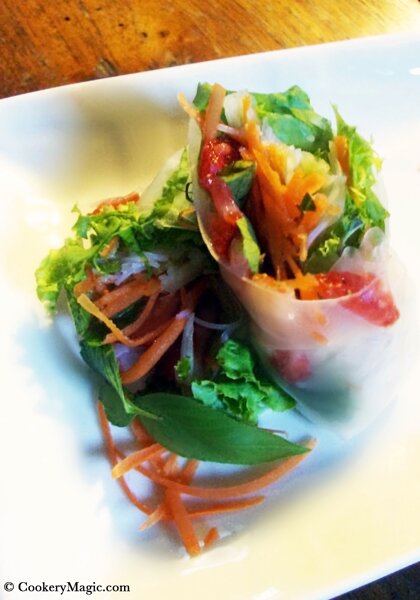Across the continent, the strawberry is getting some serious acreage.

Ichigo Daifuku - a Japanese confection of glutinous rice cake and strawberry - outside a shop in Ginza, Tokyo.
Photo credit: Nathan Duckworth
“Korean strawberries!” cries a fruit-seller outside a Singapore train station, selling them for US$3 a punnet. He tends to customers with a hurried urgency, checking over his shoulder ever so often – a makeshift table and a van parked alongside enable a swift retreat from the police. As illegal as his fruit sales may be, he’s helping to satisfy the local craze for strawberries.
Where supermarkets once stocked only strawberries from California – large, hunking fruits that tended to reward with a sour experience – Korean strawberries have been added to the fruit aisle. Smaller, (and certainly cheaper), a deeper shade of red and much sweeter than their American cousins, they’ve been lapped up by markets in the region.
Twenty three Korean farms, to be exact, work on 230000 square metres of acreage that in 2007 produced 133 tonnes, or US$1.2 million worth of strawberries for export. By 2009, 633 tonnes (US$ 4.2 million worth) left Korea’s shores for foreign consumption in the markets of Southeast Asia and Hong Kong.
There’s a statistical notion that if all the strawberries produced in California in one year were laid berry to berry, they'd wrap around the world 15 times. But China could soon beat that number – rising income levels and an appreciation for new and exotic fruit have meant the sprouting of strawberry farms across the country. China’s current acreage devoted to the strawberry stands at six times that of California; and 80% of produce goes to domestic consumption.
The strawberry isn’t as new to Asia as one would think. The majority of the 20-plus wild strawberry species occur in Asia – with China possessing more wild strawberry resources than any other country in the world. While un-eatable, such species are spearheading conservation efforts vis-a-vis wild strawberry strains. Some serve medicinal purposes, if not gastronomic enjoyment.
In Ayurvedic medicine, the wild Indian strawberry – its flesh said to taste like a poor representation of watermelon – is used as a medicinal plant, with fruit and leaves serving as a cure for skin diseases.
That said, the every-man would rather wax lyrical over the strawberry’s more eatable varieties. Strawberries are one of the few sources – along with grapes and cherries – of ellagic acid, a compound which has been shown to slow down the spread of carcinogens in the body. Ellagic acid retains its effectiveness even when whirled into milkshakes or baked into pies. Strawberries are also good sources of folic acid, potassium and fibre.
One can’t really recall the strawberry as being much of a part of Asian cuisine. But its increasing availability across the region in recent years is changing that. The Vietnamese Banh Bong Lan – a sponge cake of French origin, or biscuit au beurre – is sandwiched with fresh strawberries and cream in Vietnamese cookbook author’s Andrea Nguyen’s creation. The ichigo daifuku, ubiquitous across Japan during strawberry season, is a whole strawberry encased in Japanese red bean paste, or anko, and a layer of cooked glutinous rice flour to form a sweet, chewy dumpling.
But for a far simpler – but no less satisfying – appreciation of the strawberry, Singapore cookery expert and cooking school founder Ruqxana Vasanwala provides her vegan version of the Vietnamese rice paper roll.
Rice Paper Roll with Strawberry and Herbs
Makes 12

Ingredients
12 round rice paper
For the filling:
100 g thin rice/bean thread vermicelli
12 lettuce leaves, cut in half and ribs removed
1 carrot, julienne
1 cucumber, julienne
12 strawberries, sliced thinly
24 basil leaves
24 mint leaves
Method
1. Soak the vermicelli in 2 cups of hot water until it is soft. Drain and set aside.
2. To assemble, dip a sheet of rice paper in warm water, until it is pliable. Transfer onto a damp towel to avoid sticking.
3. Place lettuce leave on the rice paper, leaving 1 inch border on each side and at the bottom. Place 1 tbsp of vermicelli, 1 tbsp carrot, 1 tbsp cucumber, a few slices of strawberries and 2 basil and 2 mint leaves.
4. Roll the rice paper away from you and tuck the ends in halfway and finish to obtain a tight cylinder.
5. Place the spring roll on its seam on a flat dish and cover it with a damp towel and keep it the refrigerator until it is served.
6. Just before serving, cut the rice paper rolls into half on the bias. Serve with your favourite hot chilli sauce.
FOLLOW US

STAFF BLOGS
Chilli Padi
VIVIENNE KHOO
Couch Potato
ASIA!NS
Field Notes
DEBBY NG
From Jerusalem to the West Bank
DAN-CHYI CHUA
Words and Letters
CLARISSA TAN











